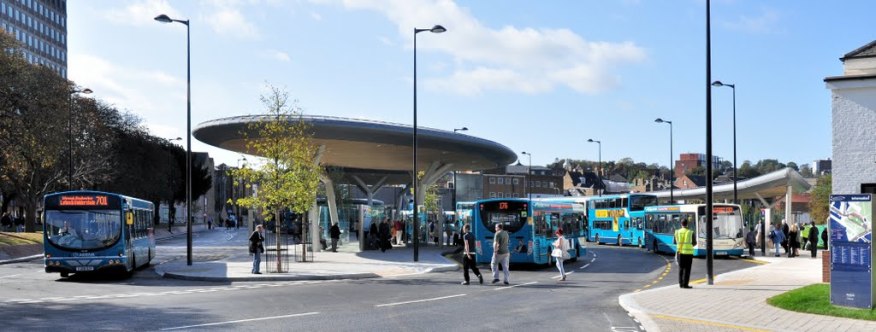
Road Network Operations
& Intelligent Transport Systems
A guide for practitioners!

Road Network Operations
& Intelligent Transport Systems
A guide for practitioners!
Key operations at terminals include Computer-Aided Despatch (CAD), platform /stand allocation, kerb/stop alignment, platform / stand announcements, and crowd control. Terminals are critical locations for realigning operations with schedules. ITS is of great benefit here in providing the information that allows vehicle controllers to adjust service levels. Vehicle control rooms are often situated in terminals therefore – which are also often the places where driving staff take their rest and meal breaks.
Infrared sensors are used for vehicle alignment and may also be used for crowd control and for passenger platform access control.
In the Transport Est-Ouest Rouennais (TEOR) system in Rouen an optical guidance system is successfully used to align the bus at the platform. An electronic suspension control enables precise vertical alignment to the platform and a gap filler installation is used for horizontal gap filling. Electronic infrared cells on the side of the vehicle detect the height of the dock and regulate the vehicle’s height with an automatic suspension system, placing the bus at the same level as the dock.
Computer algorithms may be used for allocating vehicles to specific departure platforms. Computer models may be constructed, based, for instance, on the IFOPT specification, to map out at terminals so that physical layout can be fully expressed and correct information conveyed to passengers.
Control of driver breaks is, in many countries, important to comply with legal requirements. These can take place at terminals and ITS tools can assist in their management by monitoring driver performance and adherence to schedule as well as the position and predicted arrival times of vehicles. The road network operator should liaise with operators to ensure that bus layover locations are made available on or adjacent to the road network at places where it makes operational sense to have them.
Real-time allocation of stands or stand platforms is increasing but is still a new phenomenon. A recent installation in the UK is at the new Bus Station at Chatham, in the Medway area.

Chatham Waterfront consists of four platforms labelled A, B, C and D - each with a number of individual stops on them. While the bus stop from which passengers catch their bus service may change, they will always go to the same platform for a particular destination
Large variability in road speed and unpredictable traffic congestion, combined with volatile passenger demand, can lead to pressure to abandon bus schedules in urban areas in developing economies. ITS tools can give essential information to route controllers at terminals to enable them to adjust operations efficiently - and in such a way that drivers’ hours remain within legal requirements. However, good radio links for vehicle controllers at all key locations, particularly terminals and major well-used passenger stops are vital. Vehicle controllers should also be alerted to social media broadcasts of traffic disruptions (e.g. Twitter feeds), particularly if it is not possible to provide reliable radio access to vehicles.
ITS can also assist drivers with vehicle parking in situations where there is excess capacity of vehicles - as is often the case, outside of peak hours, in developing economies.
It is essential that when communications infrastructure is planned a holistic and integrated approach is adopted, so that all parts work together to provide what is needed. The ITS should be planned into terminal design. This is relevant also to Traveller Services. (See Traveller Services)